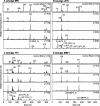Detection of active butyrate-degrading microorganisms in methanogenic sludges by RNA-based stable isotope probing
- PMID: 18408059
- PMCID: PMC2423034
- DOI: 10.1128/AEM.00045-08
Detection of active butyrate-degrading microorganisms in methanogenic sludges by RNA-based stable isotope probing
Abstract
Butyrate-degrading bacteria in four methanogenic sludges were studied by RNA-based stable isotope probing. Bacterial populations in the (13)C-labeled rRNA fractions were distinct from unlabeled fractions, and Syntrophaceae species, Tepidanaerobacter sp., and Clostridium spp. dominated. These results suggest that diverse microbes were active in butyrate degradation under methanogenic conditions.
Figures


References
-
- Dumont, M. G., and J. C. Murrell. 2005. Stable isotope probing—linking microbial identity to function. Nat. Rev. Microbiol. 3:499-504. - PubMed
-
- Garrity, G. M., J. A. Bell, and T. G. Lilburn. 2004. Taxonomic outline of the prokaryotes. Bergey's manual of systematic bacteriology, 2nd ed., release 5.0. Springer-Verlag, New York, NY. doi:10.1007/bergeysoutline200405. - DOI
Publication types
MeSH terms
Substances
Associated data
- Actions
- Actions
- Actions
- Actions
- Actions
- Actions
- Actions
- Actions
- Actions
- Actions
- Actions
- Actions
- Actions
- Actions
- Actions
- Actions
- Actions
- Actions
- Actions
- Actions
- Actions
- Actions
- Actions
- Actions
- Actions
- Actions
- Actions
- Actions
- Actions
- Actions
- Actions
- Actions
- Actions
- Actions
- Actions
- Actions
- Actions
- Actions
- Actions
- Actions
- Actions
LinkOut - more resources
Full Text Sources
Molecular Biology Databases
Miscellaneous

